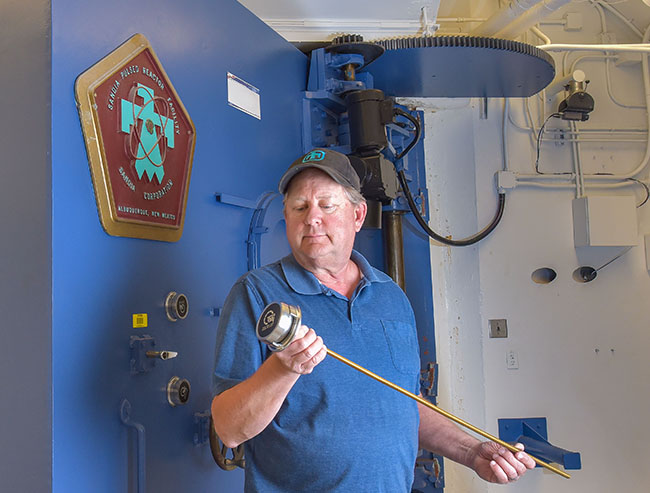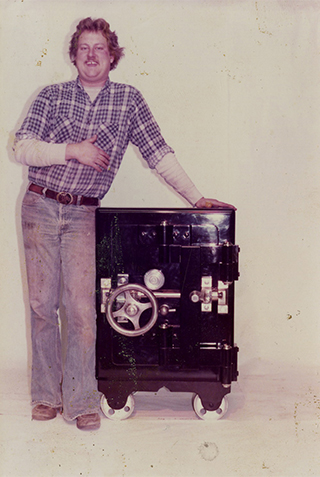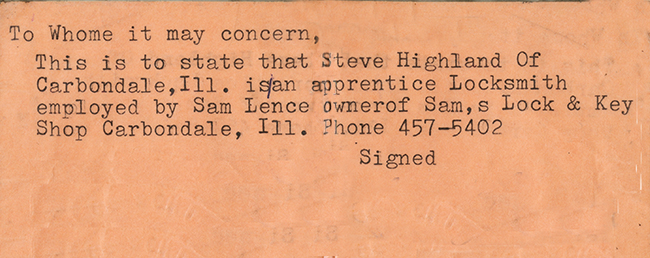Sandia’s Steve Highland becomes New Mexico’s only Certified Master Safe Technician

STEVE HIGHLAND, who started at Sandia as a locksmith in 2000, is now part of the Labs’ Access Delay and Structural Assessment organization. Steve recently completed course work and exams to become New Mexico’s only Certified Master Safe Technician.
For Steve Highland, that epic snowstorm in southern Illinois in 1984 was the last straw. As he recalls it, there were 2 feet of snow on the ground in Carbondale, the wind was crazy-bad, and the temperature — not the wind chill factor but the actual air temperature — was minus 20 degrees. And oh, the sewers froze.
The soundtrack of Steve’s life at this point could have been Eric Burdon and the Animals’ iconic “We gotta get out of this place.” Burdon sang in his distinctive, gravelly voice, “We gotta get out of this place / If it’s the last thing we ever do / We gotta get out of this place / Girl, there’s a better life for me and you.”
The young family man knew just what Burdon meant; he and his high-school sweetheart wife were ready for a change.
Steve, who had learned the locksmith trade in the early 1970s through a high school apprenticeship program, started looking around for other opportunities in the trade — in someplace warm.
In a trade publication, he learned about a job opening at a safe and lock business in Albuquerque. After looking the place up on a map, and noting that it was well south of Carbondale, he mailed off his resume. The owner was impressed enough that he decided to fly Steve out for a first-hand look. Meeting the young man and assessing his skills, he liked what he saw. So did Steve. He got the job.
The Illinois native moved his family to the sunny Southwest, with an emphasis on sunny.

During the course of his career, Steve Highland has had to learn about safe technology through the years, from antiques like this 1880s Diebold safe to the most modern high-tech digital devices. (Photo courtesy Steve Highland)
Great pickings for a locksmith
Over the next 15 years, Steve practiced his craft and continued to hone his skill set. By 1990, he had earned his “certified master locksmith” designation from the Associated Locksmiths of America. The company he worked for did some contract work for Sandia; that was Steve’s introduction to the Labs. For a locksmith, Sandia — with its 10s of thousands of locks on vaults, safes, doors, vehicles, desks, and cabinets — was fertile ground. There was always plenty to do and lots to learn. And keeping up with rapidly changing lock technology was always demanding.
In 1993, Steve started his own locksmith business and continued to do contract work for Sandia. In 2000, he joined the Labs fulltime, while his wife and son continued to run the locksmith business. At Sandia he spent several years doing familiar, if demanding, locksmith duties — everything from rekeying buildings to responding to emergency calls to helping free a distraught employee who somehow locked himself in his office.
‘A challenge every day’
Eventually, with his growing expertise, Steve moved from day-to-day locksmithing chores to Sandia’s Access Delay and Structural Assessment organization, which designs safeguards to deny access to critical resources. With his broad and deep knowledge of locks and safes, Steve brought a unique real-world perspective to the team. He knows how locks work and he knows how the bad guys defeat them. He often red-teams security systems, helping the engineers identify vulnerabilities in their designs.
Steve makes a couple of points about physical security: First, a secure system is about much more than a lock in a door; the lock is part of a more complex system. In a sophisticated system, defeating the lock may be the least of a bad guy’s problems. He’s going to find a lot of surprises on the other side of the lock, and not pleasant surprises.
Steve makes clear, too, that there is really no such thing as an impregnable system — that’s the premise behind access delay: You want to have a system that throws up barriers to entry, to slow down the bad guy long enough for a response team to foil the attempted breach. In fact, locks and safes are rated by just this factor: how long it takes a malefactor to defeat the lock using drills, acids, torches, or explosives without damaging or destroying the goods inside.
“It’s a challenge every day,” Steve says. “I never have boring days. A lot of guys come and consult with me. I love being involved in the design of physical security systems. That’s a wide realm and open to a lot of creativity. I love working with my team; they are some smart dudes.”
Realizing a long-time goal
As busy as he is, Steve recently completed what for him has been a decades-long goal: he earned his “Certified Master Safe Technician” (CMST) credential, a designation awarded by the Safe and Vault Technicians Association. It’s the PhD of the safe and lock world, with a daunting list of course requirements. Here’s a small sampling of the skills and knowledge a CMST must demonstrate: troubleshooting and dialing diagnostics; theory of manipulation; drilling; advanced borescope techniques; uncommon safes; high-security safe construction; and lots more.
“The ‘master’ certification is very tough to achieve,” Steve says. “I’m proud to be the only CMST in New Mexico, and I am a Sandian!”
Steve reflects on that first fork in the road that led him to where he is. As a high school senior, he had an opportunity to apprentice in the hospitality industry at a local Holiday Inn but opted for the locksmith program. Looking back, he’s glad he did.
“It’s my living and my calling,” he says.

WHEN STEVE HIGHLAND first started working as an apprentice locksmith, he was “busted” for trying to break into an empty house. Actually, he was on a job to rekey a vacated property. When the police approached him, he tried to explain what he was doing but the optics weren’t good: He was wearing a leather jacket and had lock-picking implements in his toolkit. His boss got him off the hook and typed up the 3×5 card above, signed it and had it notarized. Steve has kept this memento of his adventurous youth for more than 40 years.